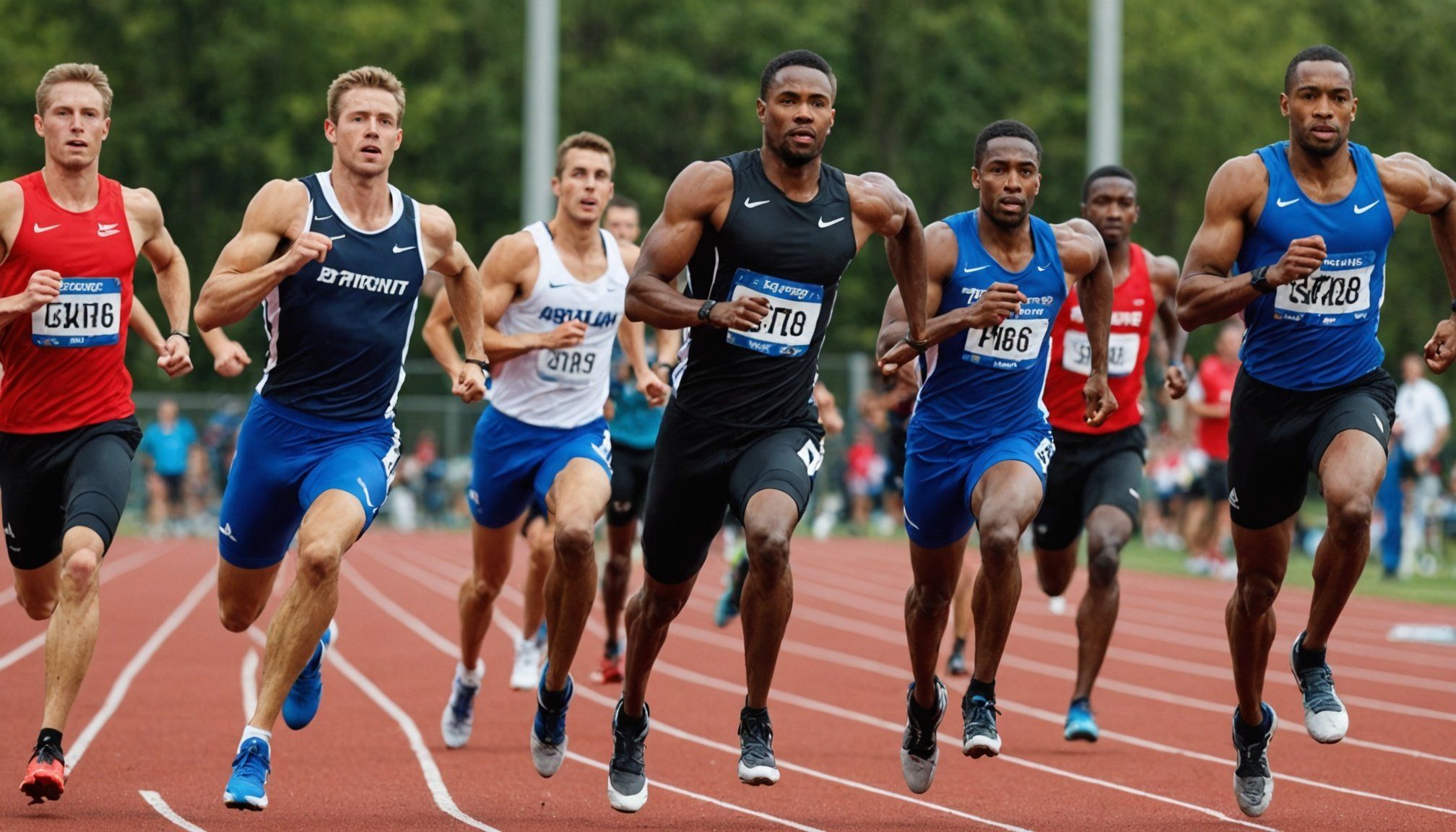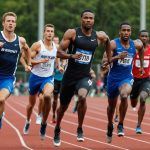Understanding the Importance of Sprint Starts
The sprint technique you employ during the initial phase of a race greatly impacts overall race performance. A well-executed start can set the tone for the entire sprint, whether you are competing in the 100m, 200m, or 400m. While each event has unique nuances, the commonality lies in the importance of explosive power and swift reaction times.
For a successful start, mastering the use of starting blocks is crucial. These blocks help athletes convert muscular explosive power into forward momentum. The key is to react with lightning speed to the starter’s signal, transitioning smoothly into maximum acceleration. Reaction time not only impacts initial speed, but it also influences energy efficiency and endurance throughout the race.
Topic to read : Mastering dive entry: proven strategies and expert tips to elevate your skills!
While the 100m demands an immediate burst of speed, the 200m requires maintaining high speed during the bend, and the 400m involves managing a powerful yet sustainable pace. Understanding these differences can refine race strategies and enhance performance. In terms of sprint starts, focus on perfecting technique, developing strength, and executing precise timing to excel in your racing efforts. Emphasizing these aspects will undoubtedly improve your competitiveness and overall sprint efficiency.
Biomechanics of a Successful Sprint Start
The biomechanics of a successful sprint start are key to unlocking maximum race efficiency. Sprint mechanics, comprising optimal body position and acceleration phase, can critically shape an athlete’s performance. Understanding these aspects enhances ability to transition from start to full speed seamlessly.
Topic to read : Mastering balance: essential techniques to elevate your surfing skills and unleash your full potential
Optimal Body Position
A key aspect of body positioning involves maintaining a low center of gravity. Proper alignment is essential, with shoulders extending past the starting line, enabling an explosive launch. This position optimizes the force exerted by the legs, facilitating greater acceleration.
Effective Use of Starting Blocks
Starting blocks offer athletes a pivotal advantage by allowing effective conversion of explosive strength into forward thrust. Correct foot placement is crucial for generating maximum force. Athletes should ensure that their back foot is firmly anchored, enabling a powerful extension through the starting motion.
Transitioning into Acceleration
Successfully transitioning into the acceleration phase is vital. This involves maintaining a steady increase in speed while minimizing energy loss. Precision in body alignment must continue post-start, maintaining forward momentum and ensuring speed retention throughout the race. The goal is to keep a seamless shift from an intense start into a sustained sprint, maintaining top speed efficiently.
Drills to Enhance Sprint Start Techniques
Incorporating sprint drills and acceleration drills into your training regimen is vital for honing efficient sprint start techniques. Key exercises focus on bolstering reaction times, where swift reflexes can make a significant difference. Reaction drills such as “reactive sprints” train sprinters to respond accurately to auditory or visual signals, sharpening start precision.
Developing explosive leg strength is another essential component. Plyometrics, which include jumps, bounds, and hops, are highly effective for this purpose. These exercises augment muscular power and enhance the explosive strength needed for a successful sprint start. Integrating activities like box jumps and squat jumps into routine workouts can lead to substantial improvements.
In addition to musculature, optimal body positioning during acceleration drills can further advance start techniques. Drills like “resisted sprints” or “hill sprints” enforce proper angles and leverage, helping athletes maintain their center of gravity and effectively transition into the acceleration phase.
To blend these elements into a cohesive training program, adopting a holistic approach that combines drills focused on reaction, strength, and body mechanics is recommended. This comprehensive method will enable sprinters to push their performance boundaries and refine their technique systematically.
Mental Preparation for Sprinting
In sprinting, mental conditioning plays a vital role in achieving peak performance. Cultivating mental toughness is as crucial as physical readiness, as it aids athletes in handling race pressures effectively. Focus techniques are instrumental in maintaining composure and concentration before sprints. By focusing on controlled breathing and positive self-talk, sprinters can heighten their psychological readiness and reduce pre-race nerves.
Visualisation is another powerful tool in the sprinter’s arsenal. Mentally rehearsing the race can prepare the mind to execute key techniques and transitions smoothly. Visualising successful starts and strong finishes helps in reinforcing confidence and sharpness in strategic execution.
A pre-race routine that includes consistent warm-ups, mental checks, and focus rituals ensures athletes maintain the required calmness and concentration. Engaging in habitual practices familiarizes the body and mind with optimal readiness, enhancing both comfort and competence when the starter’s signal sounds.
Ultimately, sprinters must balance physical preparation with robust mental strategies. Embracing techniques like visualization, focus on routine maintenance, and incorporating mental conditioning practices are essential to achieving comprehensive sprint excellence. Such holistic preparation empowers athletes to not only compete but excel on the track.
Common Mistakes in Sprint Starts
Achieving excellence in sprinting begins with addressing sprinting errors. Athletes often falter due to missteps that compromise momentum. Correcting these technical errors can significantly enhance race performance.
Common Technical Errors
Many sprinters struggle with improper body position, often rising too quickly from the blocks. Maintaining a low stance longer can drive better force application. Timing is crucial; premature movement leads to energy wastage, while a delayed start can result in valuable milliseconds lost.
Psychological Pitfalls
Mental blocks, such as anxiety and distraction, are subtle barriers. Before the race, coaching tips suggest mastering pre-race routines and focus techniques to calm nerves and sharpen concentration. Visualisation exercises, imagining powerful starts and successful sprints, fortify mental preparedness and reduce psychological pitfalls.
Poor Nutrition and Recovery
Proper nutrition strategies ensure optimal energy levels. Carbohydrates should be consumed in the days leading to the race, while hydration must be prioritized. Recovery is equally vital; effective rest allows muscles to rebuild and peak on race day. Without adequate recovery, even the most refined sprinting techniques falter. Emphasizing holistic preparation—addressing technical, mental, and physical aspects—enhances an athlete’s chance for success.
Expert Insights and Case Studies
Delving into coaching insights and elite experiences offers a wealth of knowledge for perfecting sprint starts. The expertise of seasoned coaches reveals tailored sprint techniques that have been tested on the track with notable athletes. These insights often highlight the subtleties and adjustments in sprint mechanics that can make significant differences in performance analysis during competitive events.
Studying elite athletes, one observes a pattern of meticulous attention to detail. They frequently demonstrate the benefits of personalized preparation routines, often involving refined sprint mechanics tailored to their individual strengths. By examining these case studies, amateur sprinters can glean invaluable strategies for enhancing their own starts.
Performance analysis is a crucial tool utilized by both athletes and coaches to assess sprint start efficacy. This involves dissecting various components such as body alignment, reaction time, and force application to identify areas for improvement. Through analytical evaluation, athletes can make informed adjustments, ensuring their technique yields maximum efficiency.
Understanding successful start strategies through renowned athletes can dramatically boost aspiring sprinters’ motivation and technical prowess. Integrating these lessons with comprehensive coaching tips and tailored strategies fosters an environment ripe for competitive excellence.
Video Demonstrations and Resources
For athletes eager to improve their sprint starts, leveraging visually rich resources is invaluable. Online sprint tutorials offer detailed step-by-step guidance, helping athletes refine techniques at their own pace.
Recommended Video Tutorials
Exploring curated video content can illuminate best practices in sprint technique. These tutorials typically showcase techniques from starting block setups to optimising body alignment. They provide a visual representation of effective sprint mechanics, which is crucial for understanding the nuances of proper form and skill execution.
Useful Online Training Resources
Websites offering comprehensive training exercises for sprinters are also beneficial. Platforms featuring interactive content, like instructional webinars and athlete-led demonstrations, deliver insights into effective sprint strategies. Many sites offer customizable programs to align with specific training needs, focusing on agility, speed, and power.
Engaging with the Sprinting Community
Interacting with fellow athletes through forums or social media can foster a supportive environment. Engaging in these communities offers shared tips and motivation, promoting a dynamic exchange of ideas. Athletes can benefit from others’ experiences, gaining diverse perspectives on perfecting sprint starts and sharing success stories, which reinforce confidence and collective growth.











